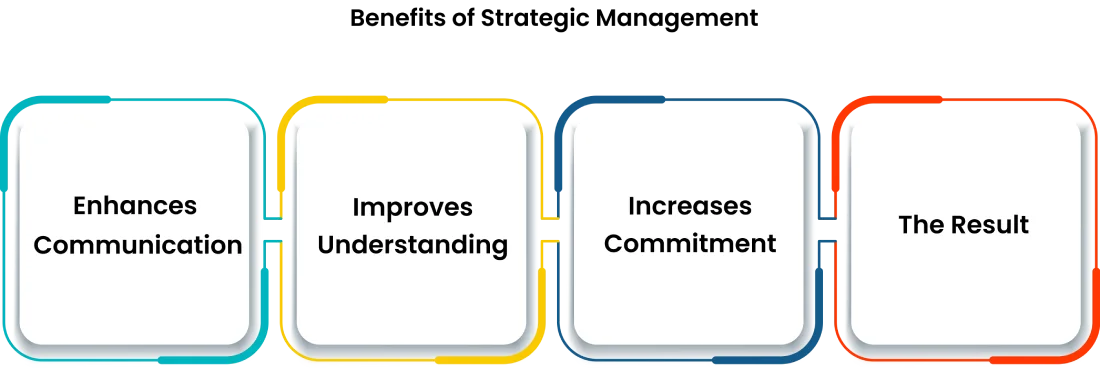Home / S / Strategic Management
Strategic Management: Meaning, Benefits, Process, and Significance
Strategic management is an important factor in the business world of today, where the survival of the fittest is the order of the day. It is the basis that aligns the vision of a company with the goals that could be implemented and managed by all departments to achieve common goals. Strategic management is an ongoing process; it does not occur once but is an on-going activity of planning, executing, reviewing, and adapting.
Being aware of the applicability of strategic management will allow leaders to create sustainable value without decreasing the efficiency of operations.
What is Strategic Management?
Strategic management can be described as the systematic process of analyzing, planning, executing, and reviewing strategies that guide an organization towards the achievement of its long-term goals and maintenance of competitive advantage.
The overall objective of strategic management is to establish direction, alignment, and performance. It also makes sure that all the actions undertaken in the organization are in line with the vision and goals of the organization.
The importance of strategic management is seen in the fact that it translates business intentions to quantifiable outcomes. It will establish lasting resilience, will allow proper communication between departments with each other, and will improve the decision-making process through organized information and vision.
Why is Strategic Management Important?

Strategic management is important because it gives an organization a sense of direction and also helps integrate resources into long-term goals. It assists leaders to forecast pitfalls, respond to market shifts, and make intelligent decisions.
- Gives Clear Direction and Vision: Strategic management defines where an organization wants to go and how to get there. It helps leaders align goals, resources, and actions toward a common vision.
- Improves Decision-Making: By analyzing internal strengths and external threats, organizations can make informed decisions based on data, not guesswork.
- Enhances Competitive Advantage: A well-planned strategy helps companies stand out from competitors by identifying what makes them unique and leveraging it.
- Encourages Proactive Thinking: Strategic management helps businesses anticipate change instead of reacting to it. This is especially useful in dynamic markets.
- Optimizes Resource Allocation: It ensures time, money, and manpower are used efficiently by focusing on the most impactful initiatives.
What are the Key Elements of Strategic Management?
These four key components define the strategic management cycle:
- Situation Analysis
This process includes the evaluation of the internal and external business environment with the help of such tools as SWOT analysis, PESTLE, or Porter Five Forces. This is aimed at finding out the competitive position of the firm.
- Strategy Formulation
When the situation is on the table, strategies are formulated to address the company's objectives. This involves defining goals, selecting markets, and making key initiatives.
- Strategy Implementation
This is the place where plans are implemented. Resources are deployed, procedures modified, and teams start working on the strategy.
- Strategy Evaluation
Constant evaluation and observation make the strategy more effective. KPIs are monitored, and feedback loops are established in order to make improvements over and over again.
What are the 5 Steps in the Strategic Management Process?

The strategic management process is a logical cycle that assists organizations in setting and attaining long-term objectives. Engaging the employees at every step enhances commitment, execution, and development of consistency at all levels.
1. Goal Setting
It begins by setting forth specific long-term goals for the organization. Involvement of the employees by seeking their opinions through surveys, team meetings, or workshops. This makes the goals realistic, applicable, and at ground level. Employees get motivated to contribute when they see the reason behind the goals.
2. Analysis
At this point, the internal strengths and weaknesses, and external threats and opportunities are considered. They will have a knowledge of ground operations and will be able to give useful information that is usually overlooked at the highest level.
3. Strategy Formulation
Strategies can be formulated based on analysis. Engage employees in pilot discussions or task forces with the co-creation of departmental strategies. By having employees involved in the plan design, they will tend to take ownership of the implementation process.
4. Strategy Implementation
It is here that the implementation of plans takes place. Define roles and responsibilities, and engage team leads in the determination of timelines and resource allocation. The routine internal communication, check-in, and joint dashboards will ensure everyone is in sync and accountable throughout execution.
5. Strategy Evaluation
Lastly, the results are quantified, and feedback is obtained. Include employees in performance reviews, retrospective meetings, or feedback. Take advantage of their experiences on the frontline, discover what is working, what is not, and how the strategy could be changed.
What are the Best Practices for Strategic Management?
- Build a feedback loop: Input from the departments should be taken continuously throughout the five stages.
- Make strategy dynamic: The trends in the market change rapidly, so should the strategy.
- Measure effectiveness using KPIs: In the absence of data, performance cannot be controlled.
- Connect operations and strategy: Align the goals of each department with strategic priorities.
- Involve all stakeholders: All the stakeholders, including interns and executives, should be made to see the reason behind the strategy.
What are the Benefits of Strategic Management?

The following are the ways through which organizations benefit in the process of strategic management:
- Enhances Communication: Communication and involvement result in a clearer and aligned culture.
- Improves Understanding: Employees can gain an understanding of the objectives of the organization and the logic of every action. This creates confidence and alignment.
- Increases Commitment: Employees are willing to work and get motivated when they come to know that their input can make a company succeed in its strategies.
- The Result: Standardized vision and mission between the departments make the overall performance and development of the business easier to achieve.
What are the common challenges in strategic management?
Most companies have a problem executing, even though it is very important. The typical obstacles are:
- Unclear objectives: Unclear objectives create confusion and a lack of alignment.
- Poor communication: Teams that are not aware of strategies fail.
- Resistance to change: Employees can resist new processes.
- Poor monitoring: Evaluation would be subjective in the absence of measurable KPIs.
- Non-integrated planning and operation: There is a lack of correlation between the implementation of strategic goals and day-to-day activities.
What is the difference between strategic planning and strategic management?
The two terms are similar, although they are not synonymous.
Strategic Planning is the process of setting long-term goals and devising a course of action to achieve the goals.
Strategy Management is the larger, enduring process that involves planning, implementation, observation, and adjustment of strategy over time.

